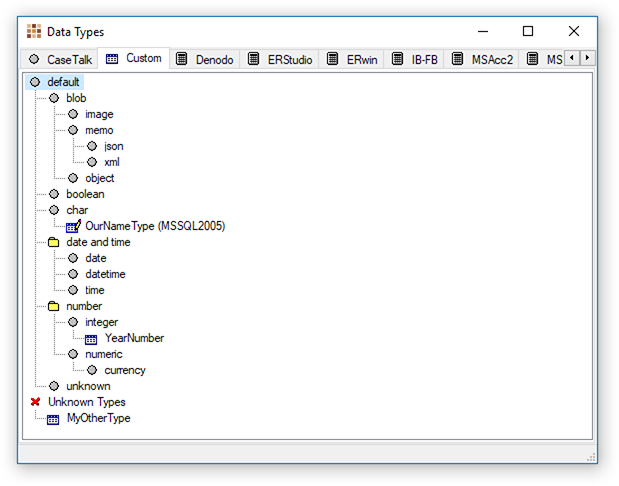Difference between revisions of "Modeler:9/DataType"
m |
|||
| Line 5: | Line 5: | ||
The user interface works entire using drag and drop functionality. | The user interface works entire using drag and drop functionality. | ||
* To register a new data type to a native or implementation type, simply drag and drop it onto it. | |||
* To change the type, drag and drop it onto a different one. | |||
* To unregister the data type as such, either press Delete on the keyboard, or drag it away from any node in the tree. | |||
[[File:CaseTalk93_DataTypes.png]] | [[File:CaseTalk93_DataTypes.png]] | ||
Revision as of 04:22, 17 August 2018
Extendable CaseTalk Data Type
DataType definition is available since CaseTalk Modeler 9.3. It allows modelers to add datatype names in the Label Type property dialog which are unknown to CaseTalk itself.
The Data Type window (located under the main menu \ tools) shows the data type hierarchy native in CaseTalk, the custom data types, and data types available under various technical artifacts.
The user interface works entire using drag and drop functionality.
- To register a new data type to a native or implementation type, simply drag and drop it onto it.
- To change the type, drag and drop it onto a different one.
- To unregister the data type as such, either press Delete on the keyboard, or drag it away from any node in the tree.
The various tabs show the scope of the data types. CaseTalk native types, custom types, and various implementation types.
Native Data Type
CaseTalk knows a basic set of types which it used to generate implementation models from. These are indicated using a solid gray bullet.
Data Type Folders
Some data types are grouped for convenience since they are similar. The folders themselves are not used in any implementation.
Unknown Types
Data type names used in Label Types in your model, which have not been recognized or added to any of the known types, are collected and shown under a red crossed icon. These are typically the types that are listed as part of model well-formedness violation (Data type must be known.)
Known Custom Data Type
New data types which are registered under a native data type (using drag and drop) will be indicated with a record like icon. These can be dragged in any of the available tabs.
Known Implementation Type
Once a new data type is assigned a native type in one of the implementation scopes, it may be made persistent across models. Custom Data Types can be promoted to and demoted from persistent implementation types by double clicking the type in the implementation tab.
The Custom tab will present the newly registered datatype under the common native type, and mention the implementation scope under which is persists.
